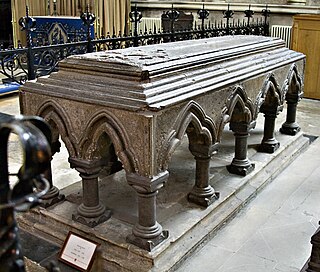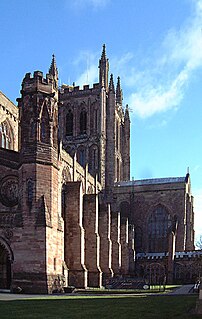Related Research Articles
Eustace was the twenty-third Lord Chancellor of England, from 1197 to 1198. He was also Dean of Salisbury and Bishop of Ely.
John Chishull or John de Chishull was Lord Chancellor of England, Bishop of London, and Lord High Treasurer during the 13th century. He also served as Dean of St Paul's.
Walter Giffard was Lord Chancellor of England and Archbishop of York.

Sewal de Bovil was a medieval Archbishop of York.
Henry of Newark was a medieval Archbishop of York.
Savaric fitzGeldewin was an Englishman who became Bishop of Bath and Glastonbury in England. Related to his predecessor as well as to Emperor Henry VI, he was elected bishop on the insistence of his predecessor, who urged his election on the cathedral chapter of Bath. While bishop, Savaric spent many years attempting to annexe Glastonbury Abbey as part of his bishopric. Savaric also worked to secure the release of King Richard I of England from captivity, when the king was held by Emperor Henry VI.
Roger Niger was a thirteenth-century cleric who became Bishop of London. He is also known as Saint Roger of Beeleigh.
Simon Langton was an English medieval clergyman who served as Archdeacon of Canterbury from 1227 until his death in 1248. He had previously been Archbishop-elect of York, but the election was quashed by Pope Innocent III.
William Langton was a medieval English priest and nephew of Archbishop Walter de Gray. William was selected but never consecrated as Archbishop of York and Bishop of Carlisle.
Roger of Salisbury was a Bishop of Bath and Wells.
William of Bitton was a medieval Bishop of Bath and Wells.
Robert de Chauncy was a medieval Bishop of Carlisle.
Seffrid II was an English cleric who served as a medieval Bishop of Chichester.
Simon of Wells was a medieval Bishop of Chichester.
John Climping was a medieval Bishop of Chichester.

Richard Swinefield was a medieval Bishop of Hereford, England. He graduated doctor of divinity before holding a number of ecclesiastical offices, including that of Archdeacon of London. As a bishop, he dedicated considerable efforts to securing the canonisation of Thomas de Cantilupe, his predecessor, for whom he had worked during his lifetime. Active in his diocese, he devoted little time to politics. He was buried in Hereford Cathedral where a memorial to his memory still stands.
William de Blois was a medieval Bishop of Lincoln. He first served in the household of Hugh du Puiset, the Bishop of Durham, then later served the household of Hugh of Avalon, Bishop of Lincoln. After Hugh's death and a two-year vacancy in the see, or bishopric, Blois was elected to succeed Hugh in 1203. Little is known about his episcopate, although 86 of his documents survive from that time period. He died in 1206 and was buried in his cathedral.
Richard of Gravesend was a medieval Bishop of Lincoln.
Henry of Sandwich was a medieval Bishop of London.
Richard Gravesend was a medieval Bishop of London.
References
- Fryde, E. B.; Greenway, D. E.; Porter, S.; Roy, I. (1996). Handbook of British Chronology (Third revised ed.). Cambridge, UK: Cambridge University Press. ISBN 0-521-56350-X.
- Greenway, Diana E. (2001). "Archdeacons: Wells". Fasti Ecclesiae Anglicanae 1066-1300. Vol. 7: Bath and Wells. Institute of Historical Research. Retrieved 23 September 2007.
- Greenway, Diana E. (2001). "Bishops". Fasti Ecclesiae Anglicanae 1066-1300. Vol. 7: Bath and Wells. Institute of Historical Research. Retrieved 23 September 2007.
- Greenway, Diana E. (2001). "Deans of Wells". Fasti Ecclesiae Anglicanae 1066-1300. Vol. 7: Bath and Wells. Institute of Historical Research. Retrieved 23 September 2007.
- Greenway, Diana E. (2001). "Subdeans of Wells". Fasti Ecclesiae Anglicanae 1066-1300. Vol. 7: Bath and Wells. Institute of Historical Research. Retrieved 23 September 2007.
- Shaw, David Gary (2004). "Button, William (d. 1264)". Oxford Dictionary of National Biography. Oxford University Press. doi:10.1093/ref:odnb/4236 . Retrieved 15 November 2007.(subscription or UK public library membership required)